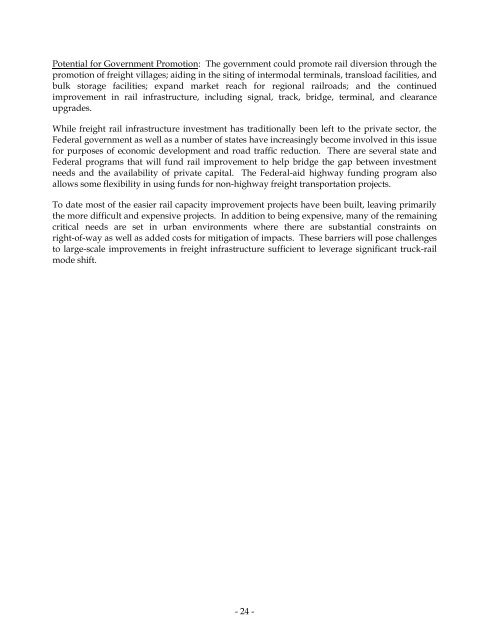Assessment of Fuel Economy Technologies for Medium and Heavy ...
Assessment of Fuel Economy Technologies for Medium and Heavy ...
Assessment of Fuel Economy Technologies for Medium and Heavy ...
Create successful ePaper yourself
Turn your PDF publications into a flip-book with our unique Google optimized e-Paper software.
Potential <strong>for</strong> Government Promotion: The government could promote rail diversion through the<br />
promotion <strong>of</strong> freight villages; aiding in the siting <strong>of</strong> intermodal terminals, transload facilities, <strong>and</strong><br />
bulk storage facilities; exp<strong>and</strong> market reach <strong>for</strong> regional railroads; <strong>and</strong> the continued<br />
improvement in rail infrastructure, including signal, track, bridge, terminal, <strong>and</strong> clearance<br />
upgrades.<br />
While freight rail infrastructure investment has traditionally been left to the private sector, the<br />
Federal government as well as a number <strong>of</strong> states have increasingly become involved in this issue<br />
<strong>for</strong> purposes <strong>of</strong> economic development <strong>and</strong> road traffic reduction. There are several state <strong>and</strong><br />
Federal programs that will fund rail improvement to help bridge the gap between investment<br />
needs <strong>and</strong> the availability <strong>of</strong> private capital. The Federal-aid highway funding program also<br />
allows some flexibility in using funds <strong>for</strong> non-highway freight transportation projects.<br />
To date most <strong>of</strong> the easier rail capacity improvement projects have been built, leaving primarily<br />
the more difficult <strong>and</strong> expensive projects. In addition to being expensive, many <strong>of</strong> the remaining<br />
critical needs are set in urban environments where there are substantial constraints on<br />
right-<strong>of</strong>-way as well as added costs <strong>for</strong> mitigation <strong>of</strong> impacts. These barriers will pose challenges<br />
to large-scale improvements in freight infrastructure sufficient to leverage significant truck-rail<br />
mode shift.<br />
- 24 -
















